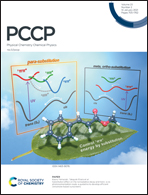Electric field controlled uphill electron migration along α-helical oligopeptides†
Abstract
A systematic study on applied electric field effects (Eapp) on electron transfer along the peptides is very important for the regulation of electron transfer behaviors so as to realize the functions of proteins. In this work, we computationally investigated the uphill migration behaviors of excess electrons along the peptide chains under Eapp using the density functional theory method. We examined the electronic property changes of the model α-helical oligopeptides, the dynamics behavior of an excess electron along the peptide chains under Eapp opposite to the internal dipole field of peptides. We found that Eapp of different intensities can effectively modulate the electron-binding abilities, Frontier molecular orbital (FMO) energies and distributions, dipole moments and other corresponding properties with different degrees. The electron-binding abilities of α-helical oligopeptides revealed by vertical electron affinity and FMO energies decrease in weak Eapp and then increase greatly in high Eapp, while the dipole moments change mildly in weak Eapp and increase significantly until a threshold and then become gentle in high Eapp. Analysis of FMO and electron distributions indicates that an excess electron can migrate uphill from the N-terminus to the C-terminus of the α-helical peptides in an irregular jump mode as Eapp linearly increases. Another interesting finding is that α-helical peptides with diverse chain lengths have different sensitivities to Eapp. The longer the peptide is, the more obvious the effects of Eapp are. Additionally, compared to the Eapp effect on linear oligopeptides, we summarized the systematic rule about the Eapp effect on excess electron migration uphill along the peptide chains. Clearly, this work not only enriches the information of the Eapp effect on electronic properties and electron transfers in the helical peptides, but also provides a new perspective for modulating electron migration behaviors in protein electronics engineering.



 Please wait while we load your content...
Please wait while we load your content...